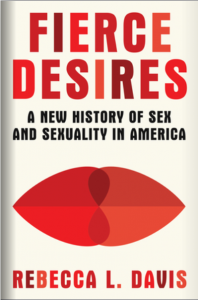Rebecca L. Davis is a Professor of History and of Women and Gender Studies at the University of Delaware. Her most recent book is Fierce Desires: A New History of Sex and Sexuality in America (Norton, 2024). She is also the author of Public Confessions: The Religious Conversions that Changed American Politics and More Perfect Unions: The American Search for Marital Bliss. She writes the Carnal Knowledge newsletter and is co-host of This Is Probably a Really Weird Question, a podcast about LGBTQ health and history. Here, I ask her about her new book, Fierce Desires: A New History of Sex and Sexuality in America published by Norton. You can follow here on Twitter @historydavis and on Instagram @rebeccadavisinsta
How have debates over the meaning and importance of sexuality shaped life in the U.S. over time?
There is a common, but mistaken, view that it was the “Puritans” of the 1600s who most strictly governed sexual behaviors as part of their pursuit of a godly society. What the evidence shows, instead, is that it was typically only when sexual behaviors threatened to upend the community’s cohesion—or drain local treasuries—that early American officials charged people with sex-related offenses. What was most important to them was the cohesion of the household, a unit that included a male husband/father with his dependent wife and children, as well as any servants or enslaved people. For that reason, we see large numbers of prosecutions for fornication (sex with an unmarried woman) and bastardy (a child born out of wedlock) and very, very few charges for sodomy. A child born to an unwed mother disrupted the patriarchal order: to whose household would they belong? Who would pay for the child’s upbringing?
The growth of the federal government after the Civil War and the expansion of local police powers in the late 1800s were major turning points. Now, local, state, and federal authorities increasingly recognized sexual behavior as an arena for government power. A key example of this shift is the Comstock Act of 1873, which barred the use of the US mail for anything considered “obscene” or related to contraception or abortion. So is the Dawes Severalty Act of 1888, which broke up Indian tribal lands and forced the formation of male-headed nuclear households. At the local level, police forces across the United States increasingly prosecuted “vagrancy” and “public disturbances,” laws that targeted growing numbers of sex workers, transgender people, men having sex with men, and other sex/gender nonconformists. During World War Two, Selective Service boards screened inductees for signs of homosexuality, and the military instituted a new policy banning gay men and lesbians—policies that would have been utterly inconceivable at any prior point in the US history. The sexual equality and liberation movements of the post-World War II United States attempted to reverse these and other punitive sexual regulations.
Today, we’re witnessing a resurgence of the regulatory impulse. But now it is confronting entire movements organized around the idea that the freedom of sexual self-expression is intrinsic to each individual’s very identity and that to punish that expression is to violate an American’s civil liberties.
How did we as a society shift from understanding sexual behaviors as personal traits to understanding sexuality as a fundamental aspect of who someone is?
This shift is one of the main threads in my book. On the one hand, Americans long believed that some people had particular “tendencies,” or “inward dispositions.” The idea was, you were supposed to be able to control those urges, so that your outward behavior reflected a morally correct character. But the government’s expansion into the regulation of sexuality, as I was describing it above, created new ways of “seeing” and thinking about a person’s erotic interests. At the same time, the expanding world of urban nightlife allowed people to create and enjoy their sexualities, whether as creators or consumers of erotic or queer performances. Individuals who resisted the government’s intensifying censure of nonheterosexual sex began to express a new theory of sexuality as a fundamental, intrinsic aspect of what makes a person who they are. By the mid-20th century, that new concept competed with the older idea that sexual behaviors reflect personal morality. Today, those two ways of viewing sexuality are in conflict.
How new are gender nonconformity, queer love, and abortion?
They are not new at all! My book opens with a story about Thomas/Thomasine Hall, an indentured servant who was investigated in 1628–1629 because members of the community disagreed over whether Hall was male or female. Hall, for their part, said they were “both.” We also know that two-spirit people existed in most Indigenous tribes across North America. We likewise can see from prosecution and church records that couples in queer or same-sex relationships lived in colonial settlements and in Indigenous nations. In single-sex schools, the military, and prisons, and also within working- and middle-class homes, queer desire was ubiquitous and occasionally even celebrated. Widespread arrests for sodomy began only in the 1890s and after, as local police forces expanded and attacked urban “vice.”
Fertility management also has ancient origins. Stress and poor diets can cause a missed period, so its absence was often interpreted as evidence of poor health, not necessarily the start of a pregnancy. Women ingested herbal concoctions to “restore” their regular flow. Those remedies might have ended a pregnancy, stimulated ovulation, or done nothing at all. In this way, women did not think of themselves as necessarily aborting a pregnancy so much as keeping themselves healthy. Well into the nineteenth century, “quickening” (the first indications of fetal movement felt by the pregnant person) was understood as the onset of a pregnancy; it might not occur until week 18–21 of a pregnancy. Historians estimate that American women aborted as many as one-third of their pregnancies during the nineteenth century.
A key contention in the movements against transgender rights, legal abortion, and queer/same-sex equality is that these are novel ideologies (rather than identities or rights) foisted on American youth by a woke left-wing sex mafia intent on corrupting minors. My book debunks all such arguments. Transgender and queer people existed long before an identity-based language of homosexual / lesbian / gay / straight and so on was coined. Movements against abortion access and queer rights ground much of their heft in a set of “history and traditions” that exclude all but straight monogamy. They ignore the powerful and widely held understanding of sexuality as a fundamental aspect of what makes a person who they are, essential to human liberty and self-expression.
Alicia M. Walker is Associate Professor of Sociology at Missouri State University and the author of two previous books on infidelity. She is the current editor of the Council of Contemporary Families blog. Learn more about her on her website. Follow her on Twitter at @AliciaMWalker1 and Instagram @aliciamwalkerphd



Comments